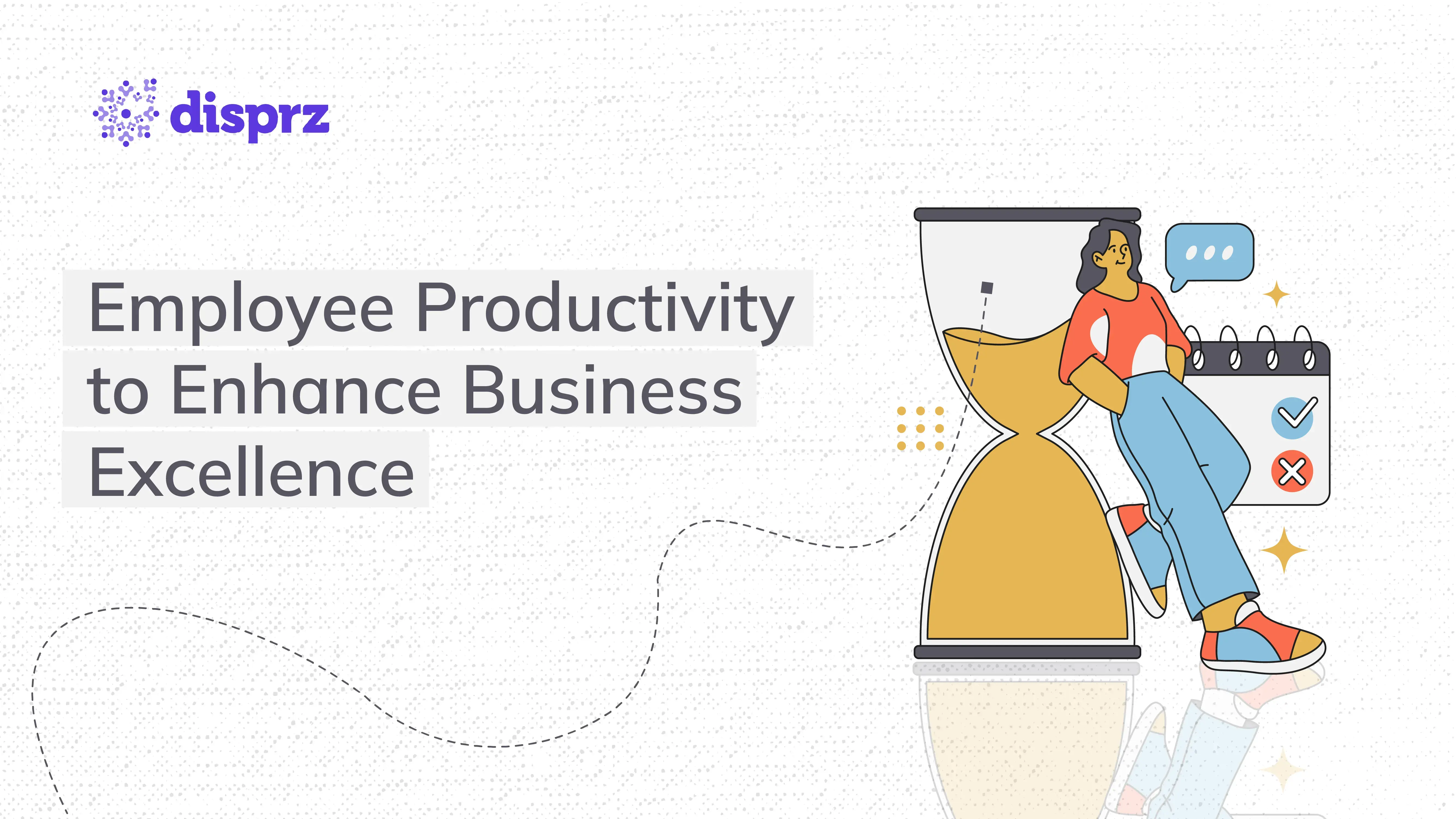Consider a scenario in which a promising tech startup is navigating its way through the competitive marketplace. The team is filled with talented individuals, each possessing unique skills and expertise. However, despite their potential, productivity within the company is struggling. Important projects are delayed, deadlines are frequently missed, and the overall work environment feels chaotic rather than efficient.
This example mirrors the reality for many organizations today, highlighting the pressing need for effective strategies to enhance employee productivity.
According to recent studies, organizations that do not prioritize productivity enhancement measures experience higher employee turnover rates, reduced profitability, and struggles to meet customer demands. As these facts underscore the urgency of addressing productivity issues within the workplace, it becomes paramount to seek expert guidance. This is where Disprz, steps in. It has consistently empowered organizations across various industries to enhance their employee productivity.
As experts in this field, we are uniquely positioned to guide you through proven strategies to elevate employee productivity, thereby propelling your business toward unprecedented excellence.
What is Employee Productivity?
Employee productivity refers to the measure of an employee's output or contribution to their organization through the resources and time they invest in their work. It is an essential metric for businesses to gauge how efficiently their workforce is performing and how effectively they are utilizing their skills and resources to achieve organizational goals.
5 Key Factors that can Influence Employee Productivity
1) Workplace Environment and Culture
A positive and supportive workplace environment, along with a healthy organizational culture, can significantly boost employee morale and motivation, leading to increased productivity.
2) Employee Engagement
Engaged employees are more committed to their work, leading to higher levels of productivity. Encouraging employee involvement and providing opportunities for growth and recognition can drive employee engagement.
3) Effective Leadership
Strong leadership that provides clear direction, support, and regular feedback can inspire employees to perform at their best.
4) Technology and Tools
Providing employees with the right technology and tools can streamline processes, automate repetitive tasks, and enhance efficiency.
5) Time Management
Effective time management strategies can help employees prioritize tasks, set goals, and maintain focus, ultimately leading to higher productivity.
High employee productivity can lead to several benefits for a company, including increased profitability, improved customer satisfaction, faster project completion, and a competitive edge in the market. On the contrary, low productivity can result in missed deadlines, higher operational costs, lower employee morale, and reduced overall competitiveness. Therefore, fostering a culture of productivity is integral to an organization's success and sustainability.
Why is Employee Productivity Important?
Increased ROI
Employee productivity is crucial for an organization's financial health and sustainability. When employees are highly productive, they can complete tasks and projects more efficiently, reducing operational costs and potentially increasing revenue. For example, a manufacturing company with a productive workforce can manufacture more products in less time, reducing production costs per unit and leading to a higher profit margin. This improved ROI directly impacts the organization's bottom line, making it a key metric for success and growth.
Competitive Advantage
Productive employees help organizations stand out by delivering superior products or services and adapting swiftly to market changes. For instance, a tech company with highly productive software developers can release innovative software updates faster than its competitors, gaining a competitive edge in meeting customer demands and market trends.
Improved Quality of Work
High productivity is linked to better work quality, resulting in greater customer satisfaction, fewer errors, and an enhanced industry reputation.
-
Cost Savings: Efficient employees lower operational costs, leading to increased profit margins or investments in other business areas.
-
Employee Satisfaction: Productivity and job satisfaction are intertwined; content employees are more likely to stay with an organization and contribute positively.
-
Innovation and Growth: Productive employees have the capacity to innovate, fostering the development of new products or services and driving organizational growth.
-
Customer Satisfaction: Employee productivity directly impacts customer satisfaction, as efficient, high-quality work leads to more satisfied customers who are likely to become loyal and recommend the company to others.
How to Measure Employee Productivity?
Key Performance Indicators (KPIs)
Use a dashboard with key performance indicators for each employee and provide access to manager to track real-time performance of the team. This facilitates the process where employees receive specific feedback tied to their KPIs, fostering a transparent and objective assessment process. Using this system,you can identify performance trends and skill gaps, allowing managers to assign learning programs that address specific needs. This enhances employee productivity and provides better visibility to managers.
Time Tracking
Implement time-tracking tools or software to monitor how employees allocate their time to various tasks. This data can reveal inefficiencies, time sinks, and opportunities for time management improvements, ensuring a more productive use of work hours.
Quality Metrics
Besides quantity, assess the quality of work produced. Quality metrics, such as error rates, customer satisfaction scores, or product/service defect rates, provide insights into employee performance and can indicate areas that require skill enhancement or process refinement.
Employee Surveys
Conduct regular employee surveys to gather feedback on their work experiences and suggestions for improving productivity. These insights can uncover hidden obstacles, boost employee morale, and lead to actionable improvements.
Project Management Software
Implement project management software to track project progress, deadlines, and resource allocation. It enhances transparency, streamlines communication, and ensures tasks are completed on time, all of which contribute to higher productivity.
Customer Feedback
Customer feedback is a valuable source of information regarding employee performance. Analyze customer reviews and comments to identify areas where your employees excel and areas that need attention, enabling targeted productivity improvements.
Manager Feedback and Assessment
Regular evaluations by managers provide valuable feedback on employee performance. These assessments can highlight strengths and weaknesses, allowing for tailored coaching and development plans to enhance productivity.
Measure ROI
Ultimately, the financial success of your organization reflects employee productivity. Monitor ROI over time and analyze how changes in productivity impact your bottom line, helping you assess the overall employee effectiveness of productivity initiatives.
10 Strategies to Boost Employee Productivity

1) Implement Clear Goals and Expectations
When employees have a crystal-clear understanding of their roles and what's expected of them, it sets the stage for focused and purpose-driven work, significantly boosting productivity. Start by conducting a skills assessment and goal-setting session with each employee, leveraging AI to analyze their strengths and weaknesses. Disprz's AI-powered platform streamlines this process by providing personalized goal-setting modules and identifying skills gap for each employee.
2) Provide Ongoing Training and Development
Encouraging continuous learning and growth keeps employees engaged and equipped with the latest skills, making them more capable and productive in their roles. Offer a variety of training modules and resources, using AI to recommend courses tailored to individual employee needs. Disprz's Learning Experience Platform simplifies this by providing an extensive library of training modules and AI-driven content recommendations.
Read how Bajaj Allianz addressed their learning and skilling challenges and achieved remarkable outcomes with Disprz AI-powered skilling platform.
3) Work-life balance
Promoting work-life balance involves creating policies that allow employees to disconnect from work when they are not on duty. Encouraging them to use their paid time off and providing flexible work arrangements can significantly improve engagement and productivity.
4) Recognize and Reward Achievements
As per Gallup/Workhuman, employees are 73% less likely to experience burnout and 56% less likely to look for a new job when their employers focus on employee appreciation. Transform your trainings into entertaining learning sessions using contests, badges, and leaderboards and allow employees to engage with your learning and training in gaminar format.
5) Effective Communication
When choosing your communication and skill development technology, prioritize platforms with robust translation tools. This ensures that all team members, regardless of their geographic location, can equally access career growth opportunities and contribute their best to your organization. Disprz excels in this regard, offering native support for multiple languages and seamless on-the-fly translation capabilities, promoting optimal communication and inclusivity across diverse teams.
6) Provide the Right Tools and Resources
With the right technology in place, team leaders can effortlessly disseminate time-sensitive direct messages to a broad audience, facilitate lateral communications, efficiently enhance the skills of the entire workforce, and access comprehensive 360-degree assessment data to monitor and optimize employee performance.
7) Time Management and Prioritization
Start by assessing the current workload and tasks. Identify critical tasks that contribute to overall goals. Prioritize tasks based on their importance and deadlines. Use tools like project management software to organize and rank tasks.
8) Improve Work Environment and Company Culture
Begin by conducting surveys, interviews, or assessments to gauge the current company culture and identify areas for improvement. Offer training programs that focus on soft skills, emotional intelligence, and cultural awareness using AI-powered learning platforms. This will also provide you with AI-driven performance analytics to measure the impact of cultural initiatives. And, you can make data-driven adjustments as needed to align with culture goals.
9) Performance Feedback and Coaching
Use an AI-powered platform to Automatically assign learning modules based on individual performance to enable the delivery of personalized coaching at scale. This dynamic approach optimizes skill development by ensuring that every employee receives tailored training designed to precisely address their unique needs and areas for improvement.
Discover PETRONAS' approach to automated learning paths tailored to employees' roles using Disprz LXP.
10) Give Incentives and Bonuses
Offer performance-based incentives and bonuses to employees, inspiring them to consistently perform at their best and drive productivity. Leverage AI-powered platforms like Disprz to meticulously track employee performance metrics, including course completion rates, task effectiveness, and KPI scores. Utilize this data to identify top performers and implement a structured reward system that recognizes and incentivizes their contributions.
Conclusion
For businesses, the correlation between employee productivity and overall success is undeniable. A highly productive workforce enables companies to adapt quickly to changing market demands, seize opportunities, and maintain a competitive edge. Enhanced productivity drives growth, profitability, and sustainability, positioning organizations to thrive in dynamic and challenging environments. Ultimately, investing in strategies to improve and maintain high levels of employee productivity is integral to achieving long-term success.
Throughout this blog, we've explored the multifaceted factors that influence productivity, spanning from the significance of a conducive workplace environment and robust employee engagement to the pivotal role of leadership and leveraging technology. We've delved into diverse methods for gauging and enhancing productivity, such as employing key performance indicators (KPIs), time-tracking mechanisms, quality metrics, and harnessing insights from employee surveys.
As organizations navigate the demands of today's market, it becomes imperative to prioritize the enhancement of employee productivity. Here, Disprz's AI-powered Learning Experience platform stands as a comprehensive solution, offering the tools and support necessary to cultivate a work environment where employees are motivated, skilled, and deeply engaged. By implementing these employee productivity strategies, organizations can create a fertile ground where productivity thrives, paving the way for sustained success and growth in the long run.











